
German postcard by Verlag Ross, Berlin, no. 1500/4, 1927-1928. Photo: United Artists. Rudolph Valentino in The Eagle (Clarence Brown, 1925).
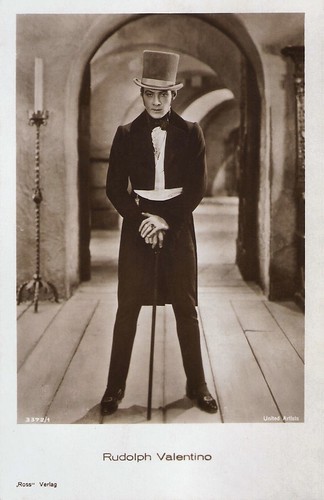
German postcard by Ross Verlag, no. 3372/1, 1928-1929. Photo: United Artists. Rudolph Valentino in The Eagle (Clarence Brown, 1925).

German postcard by Ross Verlag, 3372/2, 1928-1929. Photo: United Artists. Rudolph Valentino in The Eagle (Clarence Brown, 1925).

German postcard by Ross Verlag, no. 3376/2. Photo: United Artists. Vilma Bánky in The Eagle (Clarence Brown, 1925).

German postcard by Ross Verlag, no. 3677/1, 1928-1929. Photo: United Artists. Rudolph Valentino and Louise Dresser in The Eagle (Clarence Brown, 1925).
Dubrovsky is horrified, rejects her advances and flees
The screenplay for The Eagle (Clarence Brown, 1925) was written by George Marion jr. and Hanns Kräly based on the unfinished and posthumously published novel 'Dubrovsky' (Russian: «Дубровский») by Russian author Aleksandr Pushkin (Alexander Pushkin), written in 1832 and published in 1841. The 'Black Eagle' does not exist in the novel and was inspired by the recent success of Douglas Fairbanks as Zorro in The Mark of Zorro (Fred Niblo, 1920) and Robin Hood (Allan Dwan, 1922).
The Russian lieutenant Vladimir Dubrovsky (Rudolph Valentino), in the service of Her Majesty Czarina Catherine II (Louise Dresser), is a proud and brave Cossack. In his splendid uniform, he attracts the attention of many young ladies in love. But he has also attracted the attention of the Czarina - at the latest since Vladimir saved Mascha Troekouroff, a beautiful young lady, and her maiden Aunt Aurelia (Carrie Clark Ward) trapped in a runaway stagecoach.
Catherine the Great then wants to appoint Dubrovsky as a general, to which he is delighted. But when his ruler demands that he also becomes her lover, Dubrovsky is horrified, rejects her advances and flees. The Russian empress is furious, she is not used to such humiliation. Catherine then puts a death sentence on the unwilling Cossack's head and 5,000 rubles reward for the capture of Vladimir Dubrovsky for desertion.
Soon after, Vladimir receives terrible news from his father (Spottiswoode Aiken). The villainous nobleman Kyrilla Troekouroff (James A. Marcus) has unceremoniously seized the Dubrovskys' land and has been oppressing the local peasantry and terrorising the entire region ever since. Vladimir rushes home to find that his father has died. Vowing to avenge his father and help the victimised peasantry, he adopts a black mask and becomes the Black Eagle, a Robin Hood figure.
Posing as Monsieur LeBlanc, a French tutor, who has been sent for from France, but has not previously seen by anyone in the household, he enters the villain's home to gain his trust. To make matters worse, however, the 'black eagle' discovers that the Masha he once rescued is the daughter of the land robber and oppressor Troekouroff, Maja Troekouroff (Vilma Bánky), and he falls in love with her.
Between Vladimir, the rebel, and Masha, the daughter of the hated enemy, love grows, and Vladimir becomes more and more reluctant to continue seeking revenge against her father. Finally, the young lovers decide to flee. In the process, the Black Eagle falls into the clutches of Catherine's henchmen. The Czarina is still full of wrath towards her unruly Cossack lieutenant and initially plans to have him executed. But in the face of young fortune, she lets him go, on the condition that he leaves Russia with a new (French) name. Both young people then go to Paris and find happiness there.

Dutch-German postcard by Ross Verlag, no. 1168/2, 1927-1928. Photo: Ifa / United Artists. Rudolph Valentino in The Eagle (Clarence Brown, 1925). This vintage postcard contains Dutch text on the backside.

Italian postcard by Casa Ed. Ballerini & Fratini, Firenze, no. 676. Photo: United Artists. Rudolph Valentino and Vilma Bánky in The Eagle (Clarence Brown, 1925).

Italian postcard by Ed. Ballerini & Fratini, Firenze, no. 677. Photo: United Artists. Rudolph Valentino and Louise Dresser in The Eagle (Clarence Brown, 1925).

Italian postcard by Casa Ed. Ballerini & Fratini, Firenze, no. 678. Photo: United Artists. Vilma Bánky in The Eagle (Clarence Brown, 1925).

German postcard by Ross Verlag, no. 3676/1, 1928-1929. Photo: United Artists. Rudolph Valentino and Vilma Bánky in The Eagle (Clarence Brown, 1925).
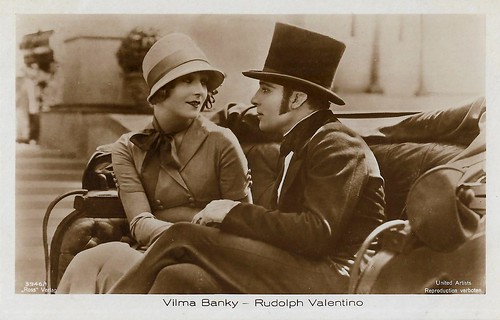
German postcard by Ross Verlag, no. 3946/1, 1928-1929. Photo: United Artists. Rudolph Valentino and Vilma Bánky in The Eagle (Clarence Brown, 1925).
Valentino at his most natural and appealing
Rudolph Valentino's last few films had not been particularly well received, but The Eagle (Clarence Brown, 1925), produced by John W. Considine, Jr., proved a strong comeback for him. The Eagle(1925) also marked Vilma Bánky's breakthrough in Hollywood. And in a tiny, unnamed role as a masked cossack, the then-unknown Gary Cooper can be seen.
The film sets for The Eagle (Clarence Brown, 1925) were made by William Cameron Menzies, and the costumes were designed by Adrian. The film was a success at the box office and The Eagle gained good reviews from the critics.
In The New York Times, Mordaunt Hall wrote at the time: "Mr. Valentino is indeed fortunate to have obtained the services of Vilma Bánky, thanks to Samuel Goldwyn, as Miss Banky is so lovely to look at that her beauty makes the hero's gallantry all the more convincing. In this production, which would have fitted well with some film celebrities such as the agile Douglas Fairbanks, Mr Valentino holds his own with flying colours. His appearance draws benefits from Clarence Brown's direction and a grateful addition from Miss Banky, a valuable asset in this film. It was also a brilliant idea to enlist Hanns Kräly, Mr. Lubitsch's clever writer, who penned the screenplay for The Eagle".
Some 90 years later, Janiss Garza at AllMovie is also positive about the film and its star: "Rudolph Valentino is at his most natural and appealing in this swashbuckler. He wears the period costumes, from the Cossack uniforms to the formal French jacket and trousers, as if they were his second skin, moving in them with a dancer's grace and casual sexuality. His Vladimir Dubrovsky is played with wit, humour, and humanity -- a revelation when compared to the stiff posturing of much of his earlier work. In addition, the star is helped at every angle: The story is action-packed and entertaining, the direction intelligent, and the cinematography (courtesy of George Barnes) is some of the most poetic of the silent era (in addition, the banquet scene contains one of the most impressive tracking shots of the 1920s)."
The Eagle (Clarence Brown, 1925) was Valentino's penultimate film, made a year before his death in 1926. Because Valentino and the Hungarian-born Vilma Bánky worked so well together in The Eagle, they were reunited again in Valentino's final film, Son of the Sheik (1926). It would become an even bigger smash. Sadly, after the release of their second pairing, Valentino stunned the world when he died at the age of 31.
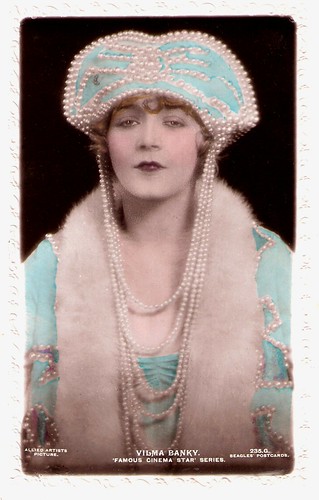
British postcard by J. Beagles & Co, LTD., London, no. 235 G. 'Famous Cinema Star' series. Photo: Allied Artists Pictures.

Austrian postcard by Iris Verlag, no. 372/2. Photo: Sascha Film. Rudolph Valentino in The Eagle (Clarence Brown, 1925).

French postcard by Editions Cinémagazine, no. 260. Rudolph Valentino in The Eagle (Clarence Brown, 1925).
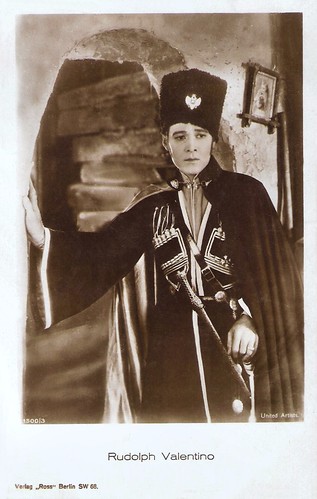
German postcard by Ross Verlag, no. 1500/3, 1927-1928. Photo: United Artists. Rudolph Valentino in The Eagle (Clarence Brown, 1925).
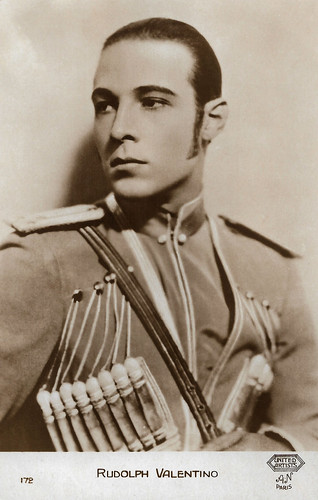
French postcard by A.N., Paris, no. 172. Photo: United Artists. Rudolph Valentino in The Eagle (Clarence Brown, 1925).
Sources: Hal Erickson (AllMovie), Wikipedia (German, Dutch and English), and IMDb.
No comments:
Post a Comment